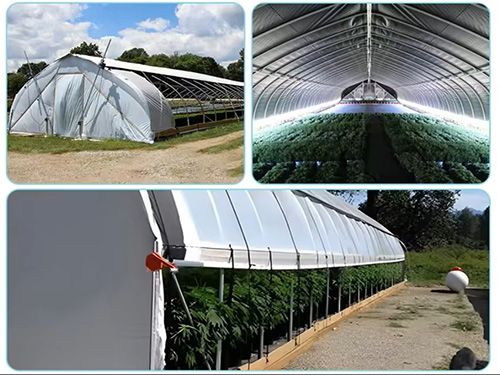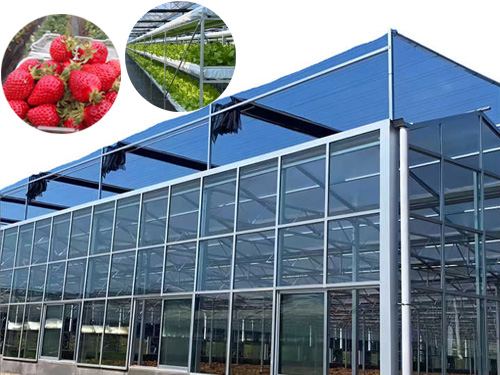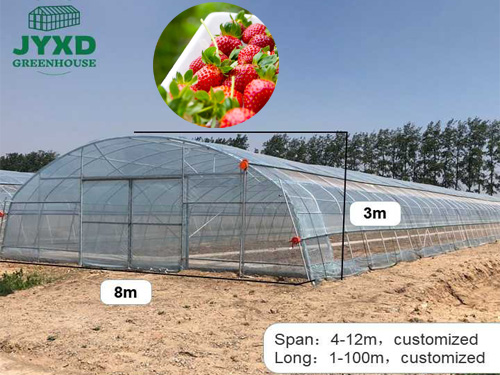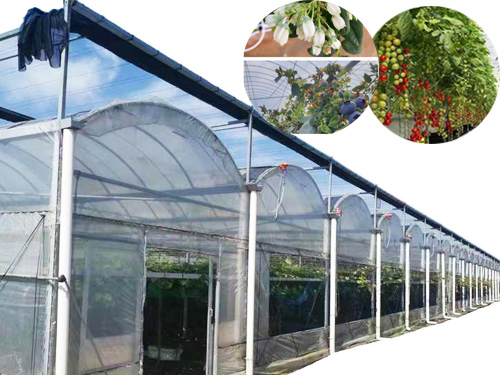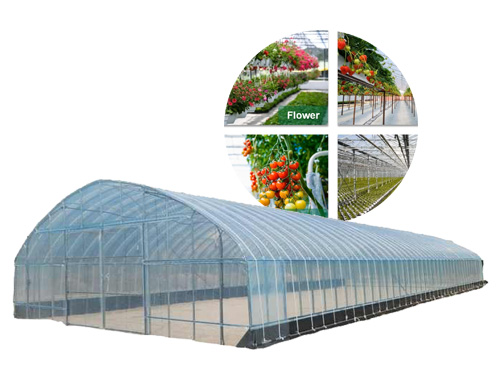NEWS DETAILS
NEWS INFORMATION
Greenhouses in Temperate Regions: Adapting to Seasonal Planting Challenges
AUTHOR:jyxd-greenhouse DATE:2025-01-22 17:42:20 HITS:114
Greenhouses have become an essential tool for extending the growing season and ensuring a stable food supply in temperate regions. These regions, characterized by distinct seasons with cold winters and warm summers, present unique challenges for agricultural production. Greenhouses provide an ideal solution by creating a controlled environment where plants can thrive, even in less-than-ideal weather conditions. In this article, we will explore how greenhouses help overcome seasonal planting challenges in temperate regions and the benefits they offer to farmers and gardeners alike.
The Unique Challenges of Growing in Temperate Regions
Temperate regions experience a wide range of temperatures throughout the year, with cold winters that can halt outdoor farming and warm summers that may lead to overexposure to heat and pests. Some of the primary challenges faced by farmers in temperate climates include:
1. Cold Winters and Frost Risks
In temperate climates, winters can be harsh, and the risk of frost can damage crops. During this time, it is difficult for plants to grow outdoors, limiting the amount of food that can be produced. While some crops can tolerate colder temperatures, many plants are vulnerable to frost, which can delay or even destroy harvests.
2. Short Growing Seasons
The growing season in temperate regions is often shorter than in warmer climates, leaving farmers with a limited window to grow crops. This can lead to challenges in timing plantings and ensuring crops reach maturity before the first frost of autumn.
3. Variable Weather Conditions
Temperate regions also face unpredictable weather patterns, with occasional droughts, heavy rainfall, or storms that can disrupt growing conditions. These fluctuations can make it difficult for farmers to plan and manage crops effectively throughout the season.
How Greenhouses Address Seasonal Planting Challenges
Greenhouses offer a way to mitigate the challenges of seasonal planting in temperate regions. By creating a controlled environment, greenhouses can extend the growing season, protect crops from the elements, and allow for the cultivation of a wider range of crops. Here are some ways greenhouses address common challenges in temperate regions:
1. Extending the Growing Season
One of the most significant advantages of using greenhouses in temperate climates is the ability to extend the growing season. By trapping heat from the sun and protecting plants from cold winds and frost, greenhouses provide a warm environment that allows crops to grow year-round, even during the winter months.
· Winter Growth: Greenhouses can be used to grow winter crops such as leafy greens, herbs, and root vegetables, which may not survive outdoors in cold weather. This ensures a consistent supply of fresh produce throughout the year.
· Early and Late Plantings: Greenhouses enable early planting in the spring and late harvesting in the fall, giving farmers the ability to take advantage of a longer growing season than what is possible outdoors.
2. Temperature Regulation and Frost Protection
Greenhouses help regulate temperature by trapping solar heat during the day and minimizing heat loss at night. This helps maintain a more stable growing environment, protecting plants from the extreme temperature fluctuations typical of temperate regions.
· Frost Prevention: Greenhouses act as a barrier against frost, reducing the risk of frost damage to tender plants. Farmers can even use heating systems within the greenhouse to maintain a consistent temperature during particularly cold nights.
· Cool Weather Crops: Certain crops, like spinach, lettuce, and cabbage, thrive in cooler temperatures. Greenhouses allow these crops to grow in the spring and fall when the outdoor climate may not be ideal for such plants.
3. Protection from Unpredictable Weather
The temperate climate is often marked by unpredictable weather patterns, including heavy rains, storms, and occasional droughts. Greenhouses provide a shelter that protects crops from these erratic weather conditions, ensuring a more stable growing environment.
· Rain and Storm Protection: Heavy rain can damage crops, especially delicate plants like tomatoes and peppers. Greenhouses shield plants from rain, preventing waterlogging and physical damage from storms.
· Consistent Moisture Levels: In the event of a dry season or drought, greenhouses can be equipped with irrigation systems that deliver consistent moisture, ensuring that crops receive the right amount of water without the risk of drought stress.
Types of Greenhouses Suitable for Temperate Regions
Different types of greenhouses offer various benefits depending on the specific needs of farmers and gardeners in temperate regions. The choice of greenhouse depends on factors such as climate, available space, and the types of crops being grown.
1. Glass and Polycarbonate Greenhouses
Glass greenhouses are a traditional choice, offering excellent light transmission, which is crucial for plant growth. They are durable and can withstand harsh weather conditions, making them ideal for regions with cold winters.
· Polycarbonate Greenhouses: Polycarbonate greenhouses are an energy-efficient alternative to glass structures. They provide better insulation, which is beneficial for maintaining temperature stability in colder climates. Polycarbonate materials also protect plants from harmful UV rays, reducing the risk of sunburn.
2. Plastic Tunnel Greenhouses (Hoop Houses)
Plastic tunnel greenhouses, also known as hoop houses, are a more affordable and flexible option for many growers. These structures use a framework of hoops covered with plastic sheeting to create a low-cost, temporary greenhouse environment.
· Seasonal Use: Plastic tunnels are often used for early spring and late fall production, providing frost protection and warmth during the cooler months. These structures are easy to set up and move, making them ideal for smaller-scale or seasonal use.
3. Geodesic Dome Greenhouses
Geodesic dome greenhouses are increasingly popular for urban farmers or those looking to maximize space and energy efficiency. These domes offer a highly stable structure that can withstand wind and snow, making them suitable for regions with harsh winters.
· Energy Efficiency: The shape of the geodesic dome helps to distribute heat evenly, reducing energy consumption. This makes them a good choice for growers who want to minimize heating costs in colder climates.
Benefits of Greenhouses in Temperate Regions
Greenhouses provide multiple benefits for farmers and gardeners in temperate climates, beyond just overcoming seasonal challenges. Some of these benefits include:
1. Increased Crop Yield
By protecting crops from the harsh elements, greenhouses help optimize growing conditions, leading to higher yields. The controlled environment allows for better management of light, temperature, humidity, and water, ensuring that plants thrive throughout the growing season.
2. Diversification of Crops
Greenhouses enable farmers to grow a wider variety of crops, including those that may not typically thrive in temperate regions. For example, tropical fruits, peppers, and exotic herbs can be grown year-round in greenhouses, offering opportunities for crop diversification and new market possibilities.
3. Reduced Pesticide Use
The enclosed nature of greenhouses reduces the exposure of crops to pests and diseases, decreasing the need for pesticides. This contributes to healthier crops and a more sustainable approach to farming, as fewer chemicals are required to manage pests.
Conclusion
Greenhouses play a vital role in adapting to the seasonal planting challenges faced by farmers and gardeners in temperate regions. By extending the growing season, regulating temperature, and protecting crops from unpredictable weather, greenhouses offer an efficient and sustainable solution for year-round food production. Whether used for small-scale gardening or large-scale farming, greenhouses allow growers in temperate climates to optimize their space, reduce risks, and produce healthy, high-quality crops in a variety of conditions. As the demand for local and sustainable food continues to rise, greenhouses are becoming an essential tool in the future of farming in temperate regions.
Hebei Juyou Xinda Greenhouse Facilities Co.,Ltd.
Copyright © 2024-2025 https://www.jyxd-greenhouse.com. All Rights Reserved Hebei Juyou Xinda Greenhouse Facilities Co.,Ltd.Copyright





 Current Location:
Current Location:


